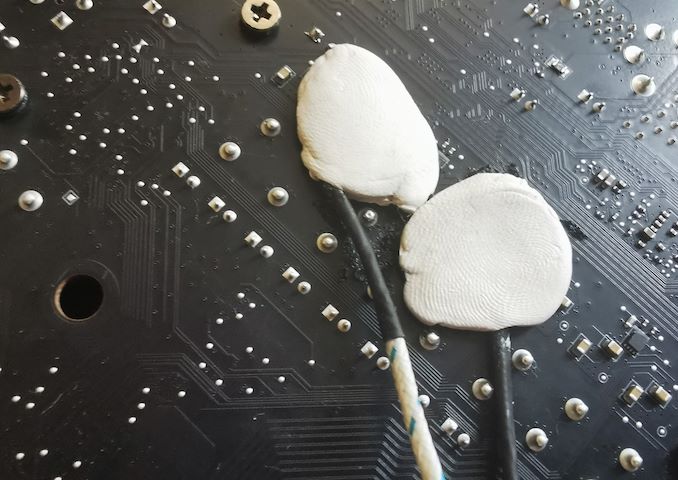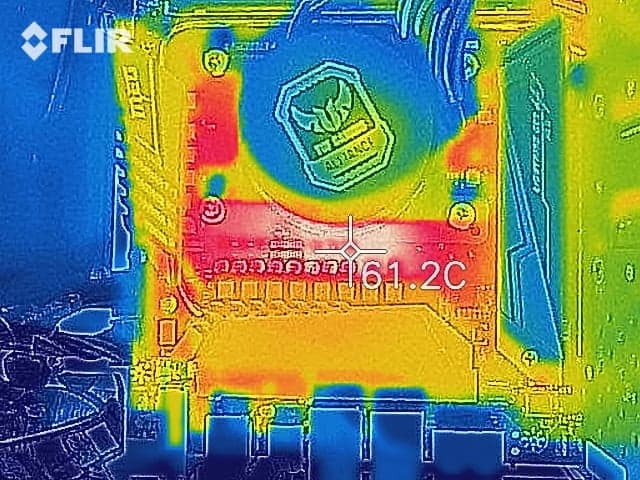The MSI MEG X570 Ace Motherboard Review: Ace in the Hole at $369
by Gavin Bonshor on July 18, 2019 11:00 AM EST- Posted in
- Motherboards
- AMD
- MSI
- AM4
- Zen 2
- Ryzen 3000
- X570
- MEG
- X570 Ace
- 3700X
- Ryzen 3700X
Power Delivery Thermal Analysis
One of the most requested elements of our motherboard reviews revolves around the power delivery and its componentry. Aside from the quality of the components and its capability for overclocking to push out higher clock speeds which in turn improves performance, is the thermal capability of the cooling solutions implemented by manufacturers. While almost always fine for users running processors at default settings, the cooling capability of the VRMs isn't something that users should worry too much about, but for those looking to squeeze out extra performance from the CPU via overclocking, this puts extra pressure on the power delivery and in turn, generates extra heat. This is why more premium models often include heatsinks on its models with better cooling designs, heftier chunks of metal, and in some cases, even with water blocks.
Testing Methodology
Our method of testing is going to focus on if the power delivery and its heatsink are effective at dissipating heat. We run an intensely heavy CPU workload for a prolonged method of time and apply an overclock which is deemed safe and at the maximum that the silicon on our AMD Ryzen 7 3700X processor allows. We then run the Prime95 with AVX2 enabled under a torture test for an hour at the maximum stable overclock we can, which puts insane pressure on the processor. We collect our data via three different methods which include the following:
- Taking a thermal image from a birds-eye view after an hour with a Flir Pro thermal imaging camera
- Securing two probes on to the rear of the PCB, right underneath CPU VCore section of the power delivery for better parity in case a probe reports a faulty reading
- Taking a reading of the VRM temperature from the sensor reading within the HWInfo monitoring application

Two K-Type Thermal Probes attached to the rear of the power delivery on the MSI MEG X570 Ace
The reason for using three different methods is that some sensors can read inaccurate temperatures, which can give very erratic results for users looking to gauge whether an overclock is too much pressure for the power delivery handle. With using a probe on the rear, it can also show the efficiency of the power stages and heatsinks as a wide margin between the probe and sensor temperature can show that the heatsink is dissipating heat and that the design is working, or that the internal sensor is massively wrong. To ensure our probe was accurate prior to testing, I personally binned 10 and selected the most accurate (within 1c of the actual temperature) for better parity in our testing.
For thermal image, we use a Flir One camera as it gives a good indication of where the heat is generated around the socket area, as some designs use different configurations and an evenly spread power delivery with good components will usually generate less heat. Manufacturers who use inefficient heatsinks and cheap out on power delivery components should run hotter than those who have invested. Of course, a $700 flagship motherboard is likely to outperform a cheaper $100 model under the same testing conditions, but it is still worth testing to see which vendors are doing things correctly.
Thermal Analysis Results

We measured 61.2°C on PCB between the CPU socket and power delivery
The MSI MEG X570 Ace uses a 12-phase CPU VCore design with an International Rectifier IR35201 running in a 6+2 configuration with six IR3599 doublers for the VCore section. This is quite an effective design and should be more than capable of handling of reaching the thermal limits of the processor long before the VRM reaches its own limits. Its heatsink also features an interesting design as the aluminium heatsinks on the power delivery is connected via a heat pipe to the chipset heatsink which is channelled around the memory slots. The chipset heatsink is actively cooled and although it is designed to keep the X570 chipset cool, it should provide a little thermal relief to the power delivery; in theory at least.
As we get more results, we will endeavour to update this chart when more models have been tested
Note - The ASRock B450 Gaming ITX-ac model crashed instantly every time the small FFT torture test within Prime95 was initiated. At anything on the CPU VCore above 1.35 V would result in instant instability. The Ryzen Master auto-overclocking function failed every time it tried to dial in settings, but it does however operate absolutely fine at stock, and with Precision Boost Overdrive enabled. Either the firmware is the issue, or the board just isn't capable of overclocking the Ryzen 3700X with extreme workloads with what is considered a stable overclock on the X570 chipset. We will re-test this in the future.
Our thermal testing shows that not only is MSI's heatsink design effective on the MEG X570 Ace, but the power delivery actually dissipates heat appropriately. We ran our AMD Ryzen 7 3700X testbed sample at 4.1 GHz with a CPU VCore of 1.475 V just to generate as much pressure as we could. We did get thermal throttling when using the maximum allowed VCore of 1.55 V and decided to dial it back a touch. The sensor integrated into the power delivery gave us a reading of 66°C after an hour of our stress test, while our VRM probe temperature sensor on the rear of the PCB gave us a reading of 61°C. It was very warm in our test area at the time of testing with an ambient temperature of between 29 and 30°C, so this probably attributed to slightly warmer conditions than usual. One of the notable aspects was that we frequently hit CPU temperature limitations before we hit VRM thermal limitations. All-in-all, the MSI MEG X570 Ace performs well under our thermal testing conditions and we have no fears that this model won't handle overclocks on any of the current Ryzen 3000 range with its effective and efficient design.











92 Comments
View All Comments
Targon - Thursday, July 18, 2019 - link
If you are looking to install a $500 CPU into a sub-$200 motherboard, you have a set of misplaced priorities. A low-end B350 motherboard may not have the VRMs to support the 105W processors, so you have to expect issues there. Also, many motherboard companies have been slacking when it comes to releasing AGESA 1.0.0.3ab based BIOS updates for older motherboards(Asus really needs to get its act together).29a - Thursday, July 18, 2019 - link
I wouldn't worry about stability or performance putting a 3700x in my $74 motherboard. You just need to make sure the CPU has been qualified by the vendor first and have a good quality power supply.Death666Angel - Friday, July 19, 2019 - link
"you have a set of misplaced priorities" Or maybe you don't do your research properly? Why should I spend money on features I don't use? A lot of sub $100 motherboards support the new 12 core and the VRMs are fine. Some will even support the 16 core and depending on air flow the VRM will still be fine. If you know what you are doing, there is no need to overspend on the motherboard "just to be safe".Some people also have different need than you. I have an mATX case and want to keep it (ITX is too restrictive and ATX is too large for my tastes). The most expensive mATX motherboards with an X370 or B450 (only one X470 board from AsRack for workstations) is the ASUS TUF 450M-Pro (sub $100) and that is probably worse than the Mortar line from MSI unless you need a very specific feature. I could go ITX but then lose 2 DIMM slots, M.2 support is more limited, VRM support suprisingly is pretty decent. But I also lose the possibility of using an extra x4 or x1 slot for future upgrades (more USB lanes, LAN card, SATA ports). I've had instances where the onboard LAN or a couple USB ports died. It's handy to have some expansion capabilities if you have the room. If I don't need the internal power, reset buttons, why pay for them? If I don't need guaranteed 4600+ MHz, why pay for it? If I don't need ALC1220, why pay for it? If I don't need more than 8 USB ports on the IO panel or more than 1 LAN port, why pay for it? Often times you get more features, but not necessarily better or more useful features when you step up in pricing. The blanket statement I quoted is really kind of ignorant.
jabber - Thursday, July 18, 2019 - link
Shhhh remember these sites have to justify their existence by pushing the concept of market churn even though most cases of tech were long since satisfied and we are largely just reheating leftovers for the past 10 years. These reviews really do cater to a ever dwindling number of tech users.satai - Thursday, July 18, 2019 - link
ECC support?Targon - Thursday, July 18, 2019 - link
There's been ECC support on motherboards since the first generation Ryzen showed up.satai - Friday, July 19, 2019 - link
Not every mobo has it official / was tested.Death666Angel - Friday, July 19, 2019 - link
The time it took to write those comments, you could have visited the website and look at the manual and provide a service to everyone.Here:
"Supports non-ECC UDIMM memory
Supports ECC UDIMM memory (non-ECC mode)
Supports un-buffered memory"
Jansen - Friday, July 19, 2019 - link
So that would be a no LOLDug - Thursday, July 18, 2019 - link
Please test the components of the motherboard, it's a motherboard review. Everyone can stick a cpu on the board and run tests. But we want to see if there are any issues or performance issues with the USB, network, sound, etc.